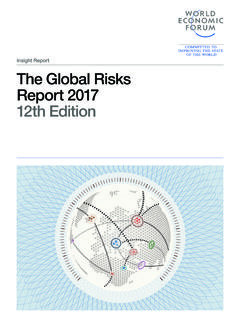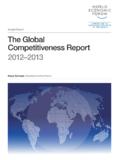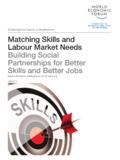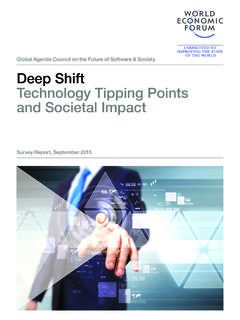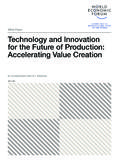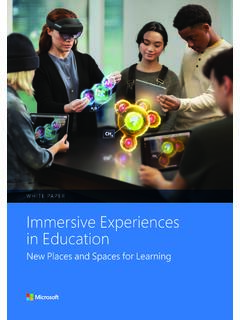Transcription of White Paper Fourth Industrial Revolution Beacons of ...
1 White PaperJanuary 2019In collaboration with McKinsey & CompanyFourth Industrial RevolutionBeacons of Technology and Innovation in ManufacturingWorld Economic Forum91-93 route de la CapiteCH-1223 Cologny/GenevaSwitzerlandTel.: +41 (0)22 869 1212 Fax: +41 (0)22 786 2744 Email: 2019 World Economic Forum. All rights reserved. No part of this publication may be reproduced or transmitted in any form or by any means, including photocopying and recording, or by any information storage and retrieval White Paper has been published by the World Economic Forum as a contribution to a project, insight area or interaction. The findings, interpretations and conclusions expressed herein are a re-sult of a collaborative process facilitated and endorsed by the World Economic Forum, but whose results do not necessarily represent the views of the World Economic Forum, nor the entirety of its Members, Partners or other Industrial Revolution : Beacons of Technology and Innovation in ManufacturingForewordExecutive summary1.
2 Lighthouses: Sites Embracing the Megatrends of the Fourth Industrial RevolutionSeeing the light: A radical leap forward for Fourth Industrial Revolution front runnersIdentifying lighthouses2. Overview of the Global Lighthouse Network3. Understanding Lighthouses: Characteristics, Differentiators and Success Factors Lighthouse characteristicsInjectors of human capitalIndustry leaders that are resetting benchmarksOpen innovators and collaboratorsLarge and small companiesFrom emerging and developed economiesHigh impact with minimal replacement of equipment4. How Do the Lighthouses Achieve Impact at Scale?Charting a course for scale: Two routesValue drivers for impact at scaleScale-up enablersThe current state of lighthousesThree tools to scale Fourth Industrial Revolution technologies in production and overcome pilot purgatory5.
3 Successful Deployment at Scale: A Close Look at Two LighthousesProcter & Gamble (P&G) Rakona, Czech Republic: Growth through cost leadershipSite historyAn inclusive visionTop five use-casesAchievements, impact and the road aheadRold Cerro Maggiore, Italy: Fourth Industrial Revolution implementation in SMEB efore and after: Transformational changesKey enablersTop five use-casesAchievements, impact and the road ahead6. Call to ActionWhy act?The Fourth Industrial Revolution is essential to breaking out of productivity stagnationThe world is under stressThe Fourth Industrial Revolution presents multifaceted opportunities and challengesWhat needs to be done? Augment, instead of replace, the operator Invest in capability-building and lifelong learningDiffuse technologies throughout geographical areas and include SMEsProtect organizations and society through cybersecurityCollaborate on open Fourth Industrial Revolution platforms and handle data carefullyAddress the climate change challenge with Fourth Industrial Revolution technologies5688810141414141515151617171 8181819202020202021222222222324242424242 4242425252525 Contents4 Fourth Industrial Revolution : Beacons of Technology and Innovation in ManufacturingWho needs to act?
4 Organizations with a lighthouseOrganizations without a lighthouseTechnology providers, start-ups and universitiesAn opportunity to form a new, global learning platform for the Fourth Industrial RevolutionAnnex: A Look Inside the Lighthouses Inside Perspectives1. Value DriversBig data decision-makingBosch Automotive in Wuxi, China Christophe Chapdelaine, Senior Vice President Manufacturing and Quality Management, Bosch Automotive Diesel Systems WuxiBabur Ozden, Founder and CEO, MaanaDemocratized technology on the shop floorNatan Linder, CEO and Co-founder, Tulip InterfacesMelonee Wise, CEO, Fetch RoboticsAgile working modeFast Radius in Chicago, USALou Rassey, CEO, Fast RadiusBosch Automotive in Wuxi, China Minimal incremental cost to add use-casesMicrosoft s manufacturing site in Suzhou, ChinaDarren Coil, Director of Business Strategy, MicrosoftMelonee Wise, CEO.
5 Fetch RoboticsNew business modelsEuropean consumer electronics manufacturer (company name undisclosed)2. Scale-up EnablersFourth Industrial Revolution strategy and business caseBMW GroupChristian Patron, Head of Innovations and Digitalization in Production System, and Marcel Eigner, Strategy Digitalization and Smart Data Analytics Production System, BMW GroupIoT architecture built for scale-upHewlett Packard EnterpriseChen Linchevski, Co-Founder and CEO, PrecognizeCapability-building through acquiring new skillsTata Steel in IJmuiden, NetherlandsHans Fischer, CEO, Tata Steel in EuropeDaiane Piva, Improvement Consultant Energy Efficiency, Tata SteelWorkforce engagementSchneider Electric in Le Vaudreuil, FranceLilian Aube, Le Vaudreuil Plant Union Representative.
6 Schneider ElectricSophie Grugier, Senior Vice President, Global Supply Chain Operations, Schneider ElectricContributorsProject TeamEndnotes2525252525262626262727272728 2828292929293030303032323232333333343435 3535353536373738 Contents5 Fourth Industrial Revolution : Beacons of Technology and Innovation in ManufacturingForewordEmitting powerful light that pierces fog and darkness, lighthouses are vital to maritime navigation. They serve as Beacons and guides, ensuring safe passage for shipping. At the World Economic Forum s Annual Meeting 2018 in Davos-Klosters, Switzerland, leaders from public and private organizations decided to seek out manufacturers in a broad range of industries who are leading the way in Fourth Industrial Revolution innovation.
7 Connected by the World Economic Forum s platform, these model factories recognized as Fourth Industrial Revolution lighthouses are beginning a unique learning journey that will benefit the production environment. Manufacturing has experienced a decade of productivity stagnation and demand fragmentation; innovation is long overdue. Organizations that have taken Fourth Industrial Revolution innovation to scale beyond the pilot phase have experienced unprecedented increases in efficiency with minimal displacement of workers. However, most companies appear to be stuck in pilot purgatory . Widespread adoption of Fourth Industrial Revolution technology at scale, through the combined efforts of companies and governments, can lead to a sizeable increase in global wealth production, benefiting people throughout society.
8 The Fourth Industrial Revolution in manufacturing remains a top priority for many leaders of private and public organizations. It is having an enormous disruptive impact on value chains, industries and business models. With one-third of the total economic value of the internet of things (IoT) coming from production,1 factories are the centre of gravity of the ongoing Revolution . While manufacturing represents 16% of global GDP,2 manufacturing industries account for 64% of global R&D However, there is potential for worker displacement if changes are not handled properly. Strengthened collaboration among stakeholders is needed to understand unexpected consequences and manage the transition. Lighthouses are demonstrators of digital manufacturing and globalization , and exhibit all of the essential characteristics of the Fourth Industrial Revolution .
9 Moreover, they confirm the hypothesis that they have the potential to generate new economic value, driven by improvements in the full spectrum of production value drivers: resource productivity and efficiency, agility and responsiveness, speed to market and customization to meet customer needs. Transforming existing production systems, innovating value chains and building new business models with disruptive potential for established businesses can create value. Lighthouses highlight the global nature of production for example, the lighthouse network includes German-owned factories in China and a site in Ireland owned by a US company. This shows that innovation is equally relevant in all geographical areas and contexts, from sourcing basic materials to process industries to advanced manufacturers addressing specialized needs.
10 Furthermore, it proves that companies of all sizes, from established global blue-chips to small local businesses with fewer than 100 employees, can achieve radical Fourth Industrial Revolution innovation. Lighthouses value collaboration and open their doors to thousands of visitors annually, recognizing that the benefits of this collaborative culture far surpass potential competitive threats. They can serve as an inspiration for defining a strategy, improving the skills of the workforce, collaborating with Fourth Industrial Revolution communities and managing changes from the shop floor throughout the value chain. While they vary in size, industry and geographic location, lighthouses embody nine common distinguishing characteristics.
